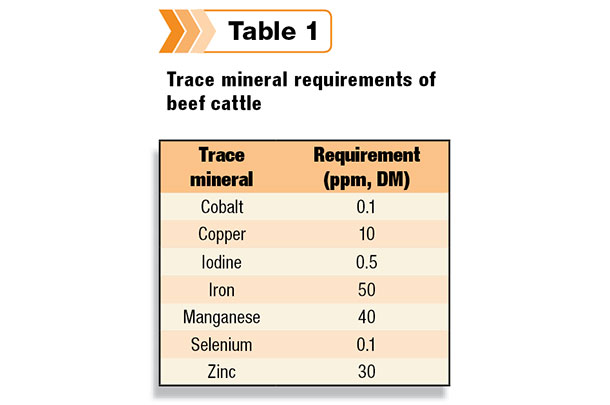Trace minerals play important roles in beef cattle diets as they perform functions in reproduction, immunity and growth. Cattle on range for extended periods of time are more prone to symptoms of trace mineral deficiencies. This is because the forage they consume is typically deficient in one or more essential trace minerals.
Trace minerals required in beef cattle diets are iron (Fe), copper (Cu), manganese (Mn), zinc (Zn), cobalt (Co), iodine (I), and selenium (Se). Forage concentrations of trace minerals can vary based on forage species, seasonality and environmental factors.
Forages in the West are prone to be deficient in Cu, Zn and Se year-round, and seasonally deficient in Mn. Therefore, it is important to develop a good mineral supplementation program and monitor your herd for signs of deficiencies.
A cow’s diet on range is typically 85-90 percent grass, with the remainder being forbs and shrubs. So it is important to know the concentration of trace minerals in rangeland grasses. In 1992 and 1993, seven north great-basin grasses were collected from April through December and analyzed for trace minerals.
Results showed concentration of Cu averaged 1.75 ppm (parts per million), significantly less than requirements of beef cattle (Table 1).

Cattle suffering from a Cu deficiency can have lighter- or faded-hair coats, severe diarrhea, brittle bones and reduced immunity. Deficiencies in Cu can be either primary or secondary. Primary deficiencies result from inadequate forage mineral concentrations.
Secondary deficiencies occur when a mineral is made unavailable because of interactions with other antagonistic minerals. Copper is a prime example of this because it can be made unavailable by elevated concentrations of Fe, Mo, S and Zn in the diet or water.
It is important to understand these antagonisms to insure cattle are receiving adequate Cu if antagonists are present.
In range forages, Fe is usually elevated and can interfere with Cu absorption. It is a good practice to test your forages for trace minerals when developing a trace mineral supplementation plan. This allows you to compare what is in the forage to your supplement. Keep in mind possible antagonisms that might create secondary deficiencies.
In the same study, Zn concentrations of forages (28.8 ppm) also did not meet the requirements (Table 1) and declined from April to December. Cattle immune systems, enzyme production and hoof health are heavily influenced by Zn. Signs of deficiency are reduced intake, excessive salivation, rough hair coat, hair loss, swelling of feet and legs, thickening of the skin and lesions.
Selenium can also be deficient in rangeland forages. However, Se can be a tricky trace mineral to supplement because of the narrow window between deficiency (<0.2 ppm) and toxicity (2 ppm). The most noticeable symptom of Se deficiency is white-muscle disease in calves. Cattle deficient in Se typically suffer from reduced conception rates, retained placentas and increased abortions.
Manganese can be seasonally deficient. Cheatgrass can contain adequate concentrations of Mn early in the growing season and maintains adequacy into late fall. In late fall, blue bunch wheatgrass and bottlebrush squirreltail contain adequate concentrations of Mn.
On range landscapes containing a combination of these species, forage may meet a beef cow’s requirements for Mn throughout the season. However, you should still supplement Mn because deficiencies lead to depressed reproductive performance.
Cobalt and iodine are not typically deficient in summer range forages, however it is still important to include them in mineral supplementation. Deficiencies in iodine can cause cows to give birth to blind, weak, hairless or stillborn calves and cause goiter.
Precipitation also affects forage trace mineral concentrations. Forage mineral concentrations are actually higher during dry periods, with the exception of Se that can be elevated in wetter conditions.
During a drought, plants cannot reach full maturity and trace minerals within their tissues becomes concentrated. During normal growing conditions, uptake of minerals from soil is quick, but mineral content declines as the plant matures because minerals are concentrated in the roots and become diluted throughout the plant as it matures.
Further, as the plant grows, the production of dry matter material takes priority over mineral uptake, creating a decline in mineral concentration and accumulation.
Different soil types also vary in trace mineral concentration, affecting trace mineral concentrations of the forages. In sandy soils, trace minerals will leach through the top layer of soil more easily than in clay soils. This is especially true where sandy soils are typically deficient in Cu and granitic- and volcanic-derived soils are deficient in Se.
As trace mineral concentrations of forages can be erratic, supplementation can increase the likelihood cattle are receiving trace minerals to meet their requirements (Table 1).
Supplementation to meet the needs of cattle can be difficult to achieve due to interactions between specific minerals within the rumen and limited knowledge of minerals provided through forage in an area, as well as at certain times of the year. Trace minerals can be provided to cattle on range in a variety of ways including free-choice (block or lick), injections and boluses.
The most popular form of supplementation is free-choice minerals. These are easy to use, and insure trace mineral intake. One issue is cattle do not consume to their mineral requirements but rather on their taste to salt. This creates variation in your cattle’s trace mineral status as some cattle over-consume, while others under-consume.
When using free-choice minerals, it is important to read the label and understand what forms of the mineral are provided and their availability for use by the animal. Some common forms are inorganic salts, sulfates, oxides and chlorides. Not all sources are equal in their availability to the animal. Some of the least available are inorganic salts and oxides.
In contrast, organic and chelated trace minerals are able to bypass the rumen and are utilized at higher concentrations. Organic and chelated minerals are typically more expensive, so discuss with a nutritionist or local veterinarian on the best option.
Studies have observed cattle supplemented with organic trace minerals have increased growth, pregnancy to A.I., and bull breeding than cattle supplemented with inorganic sources.
In situations where trace mineral supplementation may be difficult, long-acting reticulorumen trace mineral boluses are a viable option. When boluses are used it is important to administer them in the spring prior to turnout. Studies have shown increases in trace mineral status of cows and their calves.
Trace mineral injections are also a good option. These products are typically administered prior to times of increased need such as pre-calving and breeding in cows, and birth and weaning for calves. The benefit of an injectable is their rapid availability. After the initial spike in the blood, trace minerals from the injection can be stored in the liver for up to three months.
Studies have shown administering injections before calving and breeding increased cows’ body condition from calving to A.I., greater conception to fixed-time A.I. and a more favorable calving distribution the subsequent year. Injectable trace minerals and boluses are not designed to be the only form of mineral supplementation but rather an assurance every animal gets the trace minerals they require.
Trace mineral deficiencies can be hard to identify. When deficiencies go unrecognized and uncorrected, higher production losses can occur and the treatment of the deficiencies will be more costly. Develop a mineral supplementation plan that fits the environment in which the cows are located.
Start by looking at the dominant soil type of the region (USDA - Web Soil Survey). Next, consider the forage trace mineral concentrations by having the plants analyzed. Use test results to determine what free-choice supplement works for your cattle.
Remember to consider antagonists such as high levels of Fe that could be exacerbated by additional Fe provided by the supplement. You might consider trace mineral boluses and injections if adequate supplementation is difficult to achieve by other means. ![]()

-
Carmen J. Willmore
- Lincoln County Extension Educator
- University of Idaho
- Email Carmen J. Willmore








